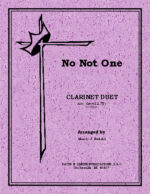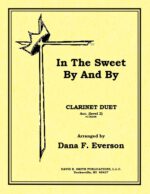-
A Passion For Thee
$8.00This clarinet trio begins with a delightful moving motive in the piano to be joined with the first part, then a duet with part two and then a trio with all three parts. The next section is solemn as the piano drops out and then all join in for an active presentation. The last section begins the theme in the third part with some imitation from part two until the first part takes over the theme and continues in this manner. The coda is simple giving a sense of peace.
-
-
To God Be The Glory
$6.00This duet with piano uses some expressive, interactive cadenza work between the duet parts in the beginning and during the work. It is vigorous in nature otherwise and ends with a torrent of joy!
-
Like A River Glorious
$7.00This clarinet duet would be useful as a special presentation in a service. The nature of the work portrays great joy, variety, and dimension. The conclusive sections are deliberate and strong.
-
No Not One
$6.00This clarinet duet is presented in a rather simple two part fashion. Subsequent verses engage contrapuntal diversity of the melody line versus the harmony. A stirring rendition for any venue.
-
Our Great Saviour
$5.00This duet is unaccompanied and includes both simple duet movement as well as contrasting contrapuntal activity between the parts. As the piece progresses more activity and joy is expressed and ends on a high note giving way to the essence of the title.
-
Three German Carols
$6.00A duet for clarinets and piano and is presented as a suite. Titles include “God Is Love- Gott Ist Die Liebe,” “With the Shepherd Will I Go- Mit Den Hirten Will Ich Gehen'” “Come Hither Little Children- Ihl Kinderlein Komet.” Can be performed as a solo.
-
Three German Carols #2
$6.00A duet for clarinets and piano and is presented as a suite. Titles include “Christmas Is Here- Weinacht Is Heut,” “Alle Jahre Wieder,” “Come, Ye Shepherds- Kommet, Ihr Hirten.” Can be performed as a solo.
-
In The Sweet By and By
$6.00An accompanied clarinet duet which begins with a melodic motif and then presents the hymn tune in untision my the two parts. The chorus then breaks into a duet harmonization in a straight forward manner. The next section presents the first part in a melodically altered rendition with the second part answering in an obbligato like fashion. The middle section is a Q&A forma with the piano dropping out, followed by a piano solo section. A modulation now gives rise to the second part acting as a solo, followed by another moduation where the first takes over as a soloist. Then another modulation and then the two parts present the chorus in a straight duet section. Where it remains until the end- as a strong final ending.
-
Silent Night
$6.00Scored for two woodwind instruments with piano, the piece begins with a solo line and then adds the duet line. The ending section does much the same only with more rhythmic enhancement. An easy piece but gives opportunity for much expression.
-
Rejoice Greatly Ye Daughters of Zion
$6.50Taken from the “Messiah”, this clarinet solo with piano is essentially a transcription of the original work. The balance in the writing between the solo and the accompaniment gives way to the sensitivity of the text of this well-know aria..
-
Lily of the Valley
$5.50A solo that is joyous and exhuberant expressing the finding of the Savior, followed by a tender expression of thoughtfulness and pondering. The final sections of this joyous piece breaks into a flurry of rapture ending on a high note of praise.
-
Guide Me, O Thou Great Jehovah
$5.50This clarinet solo with piano, this piece is written in march style displaying great resolve. The central sections present new thematic material followed by modified titled hymn materials giving a sense of unity to the piece. It ends with a solid flourish.
-
-
He Lives
$5.50This is a clarinet solo that displays a great deal of exuberance. The opening statement is very close to the originally tune. It pauses for a reflective moment and then continues its joyful way. The tune is then presented in a very rhapsodic manner ever increasing the joy of the theme, It concludes with a cadenza exploding into a final flourish.
-
I Know Whom I Have Believed
$4.50A piano introduction begins in a vigorous manner and is then joined with the soloist in a brilliant manner of a decorated melody. Coming to the chorus the solo is more fluid and expressive. After a modulation the soloist is offered an opportunity to express the tune with a great deal of flair. The middle section is slower in a thoughtful presentation. The final section regains the flair of the earlier sections and ends on a final long note of resolve.
-
Higher Ground
$5.50A rather jovial introduction is begun by the piano and then joined in by the soloist stating the melody’s verse and then the chorus in a modified form. The second verse is presented in a pleasing way underpinned by the piano using a harp-like accompaniment. And once again, the chorus is presented in a even more modified way. The coda section continues with the flavor of the piece in a motivic manner and then arrives to the final destination in repose.
-
There Is A Fountain
$5.50A solo that starts out with a flourish and continues to bubble its way melodically and with variation. The middle section is a tender reflection of the price paid by Christ for one’s redemption. It then gains anticipation for a strong ending of consecration only to come to a posture of repose.
-
My Faith Has Found A Resting Place
$5.50This clarinet solo begins with a brief piano introduction and presents the tune in a gently embellished manner that creates interest. After a brief intermission the soloist presents the tune with even more melodic embellishment and ryhthmic activity. Another intermission coupled with a modulation where the piano now carries the tune while the soloist offsets it with a countermelody, The solo line now captures the tune and carries it to the end where it makes a final, restful statement.
-
Satisfied
$4.50This solo begins with a elegant little motif in the upper register of the piano and then moves downward to a simple accompanying figure. The solo enters in a gentle manner with minor modifications- very much in a restful manner. With an abrupt modulation the tune is modified once more in a different way. After two more modulations in the piano the soloist presents the tune with a more “arpeggiated” way and then settles into a final long note- as if “everything’s okay!”
-
What A Friend
$4.50This solo begins with a polite introduction and then is joined with the soloist in a gentle alteration of the tune in its entirety. A second verse is modulated upward with the tune with even more variation. After more modulations there is a brief cadenza and then a coda section based on the opening motif of the tune.
-
Tender Night Medley
$5.50This solo is presented in a lush, relaxed format which incorporates the carols “Silent Night”, “Away In A Manger”, “It Came Upon A Midnight Clear”. The solo line is altered rhythmically to give a sense of child-like gentleness while the accompaniment gives a restful underpinning of lush harmonies.

























